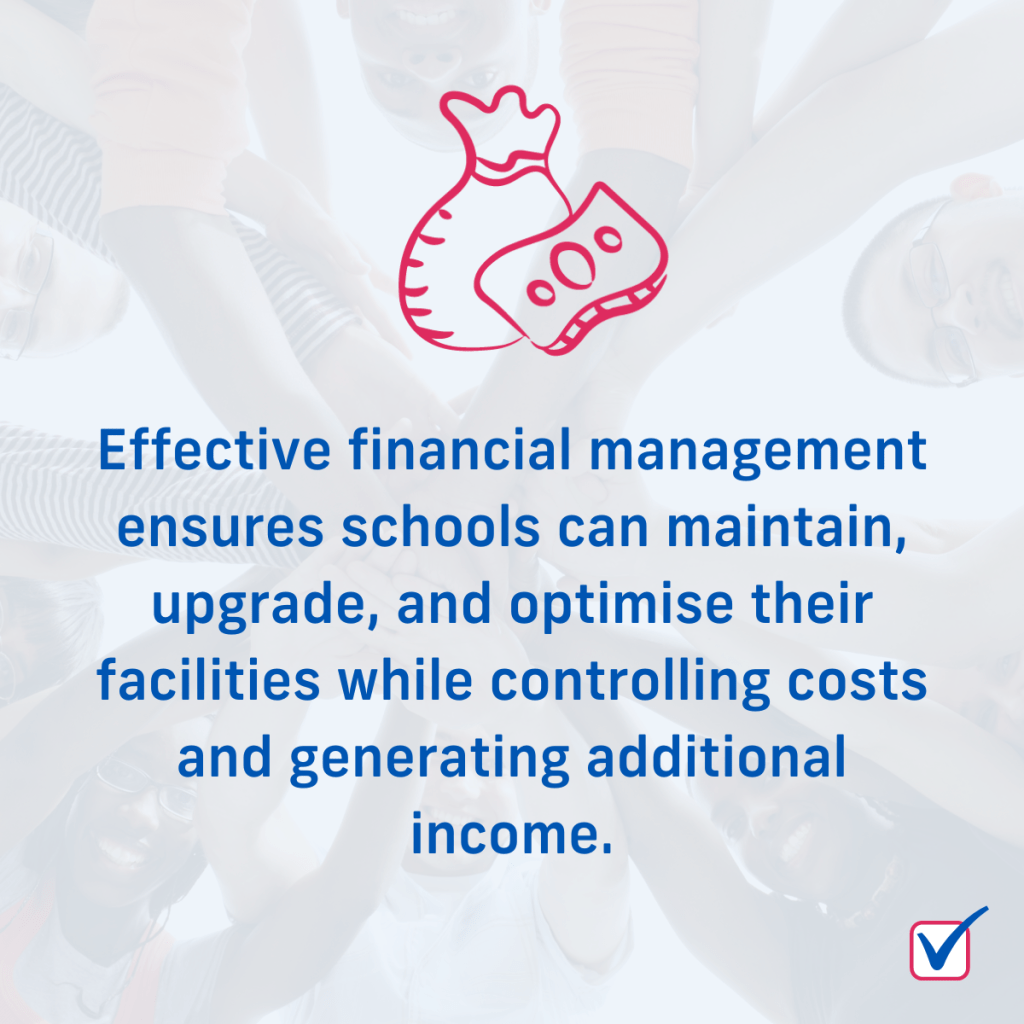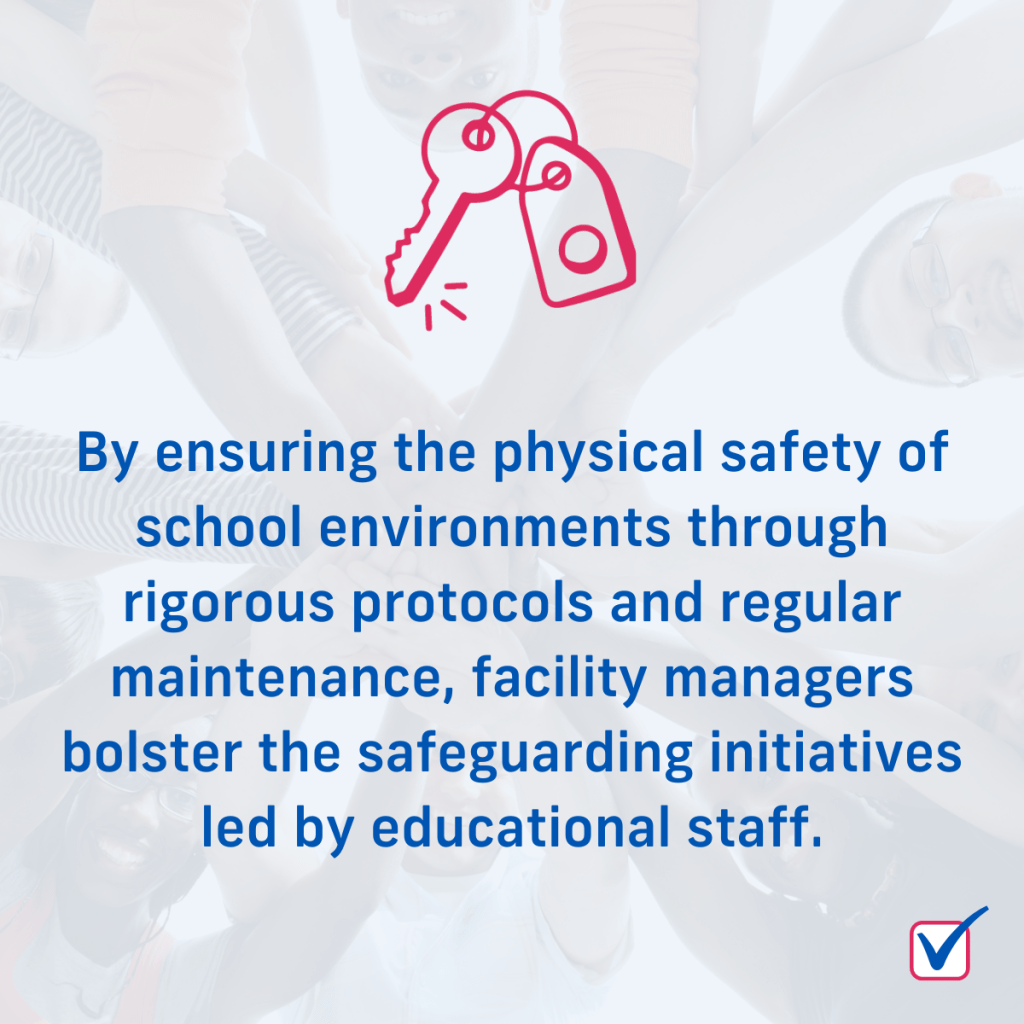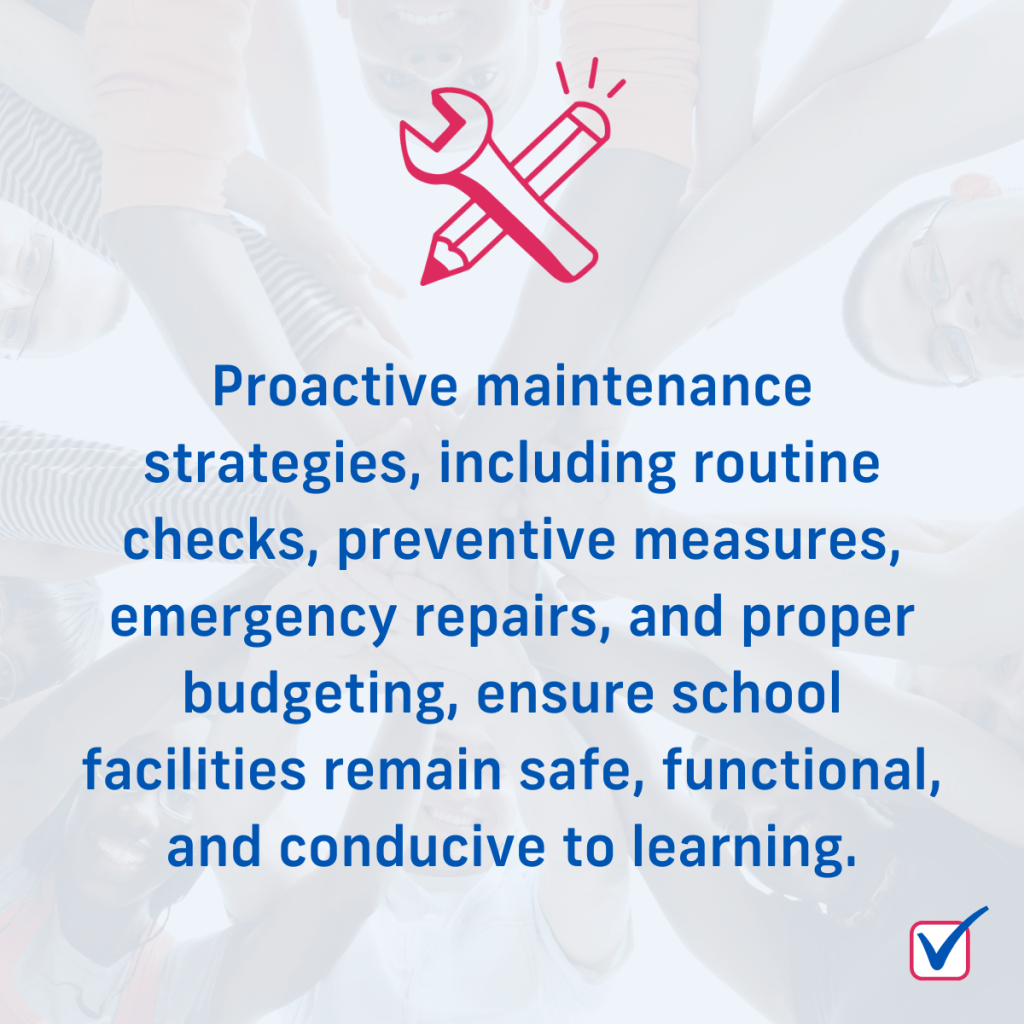The Complete Guide for School Facility Management
Learn everything about school facility management with Bookteq—comprehensive insights on development, upkeep, lettings, and more.

Learn everything about school facility management with Bookteq—comprehensive insights on development, upkeep, lettings, and more.

School facility management involves the comprehensive oversight and maintenance of school facilities, encompassing aspects such as development, maintenance, and operational management. It ensures that educational environments are safe, efficient, and conducive to learning. Key components include space planning, energy management, safety protocols, and the coordination of services to support the educational mission of the institution. Additionally, effective school facility management involves managing costs and identifying opportunities for revenue generation, such as through facility rentals and energy savings.
Key components of school facility management include:
Financial Management: Focuses on budgeting, financial planning, and revenue generation to maintain and enhance educational environments. This includes securing funding, implementing cost-saving strategies, and generating additional income through facility rentals and events.
Facility Safety & Pupil Safeguarding: Ensures the physical environment is safe and secure, supporting the broader safeguarding efforts of educational staff. This involves conducting risk assessments, maintaining safety equipment, implementing security measures, and developing emergency preparedness plans.
Facility Utilisation and Space Management: Maximises the use of school facilities through effective space planning, scheduling, and community engagement. This includes optimising classroom space, event space and sports facilities – managing bookings, and fostering partnerships to enhance facility usage.
Facility Maintenance: Encompasses routine inspections, preventive maintenance, and emergency repairs to keep school facilities safe and functional. This includes regular upkeep of building systems, sports facilities, and playgrounds to prevent issues and ensure a conducive learning environment.
Facility Development and Design: Involves planning and designing new facilities, renovating existing spaces, and incorporating sustainable practices. This includes collaborating with architects and engineers to create functional, flexible, and eco-friendly learning environments that meet current and future needs.
Community Involvement and Access: Engages parents, local businesses, and volunteers to support the effective management and utilisation of school facilities. This includes organising community events, forming partnerships for resources and support, and establishing volunteer programs to enhance school activities and facilities.

Financial management is arguably the most critical aspect of school facility management, as it directly affects the ability to maintain and enhance educational environments. Effective financial management begins with meticulous budget planning and allocation, ensuring resources are efficiently distributed to meet operational needs and long-term goals. This involves prioritising essential maintenance and strategic upgrades while managing expenditures to avoid overspending.
Additionally, implementing cost-saving strategies can significantly reduce monthly expenses and overheads. Schools can lower costs through energy-efficient upgrades, regular maintenance, and waste reduction initiatives. Exploring funding sources and grants provides essential financial support for facility improvements, while revenue generation strategies, such as renting out facilities or hosting events, can offer additional income. By integrating these approaches, schools can sustain their facilities, support educational excellence, and adapt to evolving needs.
Find out how to use your school facilities to generate revenue, and see how much revenue schools in the UK generate from lettings in this 2024 State of School Lettings Report. Use this reports to benchmark your facilities, identify opportunities for growth, and elevate your revenue potential.
Did you Know? that the average school in the UK makes an additional £40,500 from community lettings per year? While we’ve also seen top performing schools, such as Beaumont School, Highgate School, and Haberdashers’ Academies Trust South, make over £150,000 per year from school lettings.
If you are seeking funding opportunities, explore this school grant search tool online. For funding specifically for sports facilities, please refer to this facility funding list to see which options your school might qualify for.
Facility safety and pupil safeguarding are interconnected areas where the school facility manager plays a crucial supporting role. While the primary responsibility for pupil safeguarding lies with designated safeguarding leads and educational staff, facility managers ensure that the physical environment is safe and secure.
Safety Protocols and Risk Assessments: Facility managers ensure the school environment is physically safe by conducting regular risk assessments, maintaining safety equipment, and ensuring compliance with health and safety regulations.
Security Measures: Implementing and maintaining security measures such as surveillance cameras, secure entry systems, and visitor management protocols are vital tasks for facility managers. These measures protect students from external threats and unauthorized access.
Emergency Preparedness: Facility managers help develop and execute emergency preparedness plans, including fire drills and lockdown procedures, ensuring that students and staff know how to respond in various emergency situations.
Maintenance of Safe Environments: Regular maintenance of buildings and grounds, including playgrounds and sports facilities, is crucial to prevent hazardous conditions that could harm students.
Collaboration with Safeguarding Leads: While not directly involved in the day-to-day aspects of pupil safeguarding, facility managers work closely with safeguarding leads to ensure the physical environment supports broader safeguarding policies and practices.
For more on the role of facility managers in creating safe school environments, resources such as the Health and Safety Executive (HSE) and the Department for Education’s Health and Safety Guidelines are helpful.

Facility utilisation and space management are critical components of effective school facility management, ensuring that all spaces are used efficiently and meet the needs of students and staff.
Space Planning and Allocation: Effective space planning involves evaluating the school’s needs and strategically allocating areas for classrooms, offices, recreational spaces, and specialised facilities. Proper planning ensures that each space serves its purpose and meets safety and accessibility standards.
Scheduling and Event Management: Managing the scheduling of classes, extracurricular activities, and events is crucial for optimal space utilisation. A well-organised scheduling system helps avoid conflicts and ensures that facilities are available when needed. Digital scheduling tools can streamline this process, making it easier to coordinate various activities.
Maximising Facility Usage: Schools can maximise the use of their facilities by opening them up for community events, after-school programs, and rental opportunities. This not only ensures that spaces are used to their full potential but also generates additional revenue for the school. Bookteq offers schools three management options for community lettings, helping schools make the most of their facilities by renting them after school hours and on weekends. More information can be found at Bookteq School Lettings.
3 Management options to consider when hiring out school facilities
8 Considerations for Schools Adopting a Digital Booking System
Effective maintenance is crucial for ensuring that school facilities remain safe, functional, and conducive to learning. A proactive maintenance strategy helps prevent issues before they become major problems, ensuring a smooth and uninterrupted educational experience.
Routine Maintenance: Regular, routine maintenance involves scheduled checks and upkeep of building systems, such as heating, ventilation, and air conditioning (HVAC), plumbing, and electrical systems. For general school buildings, this includes tasks like changing filters, inspecting for leaks, and testing emergency systems. For sports facilities, routine maintenance also includes inspecting and maintaining sports equipment, pitches, courts, and swimming pools. Ensuring these areas are in top condition is essential for safety and performance.
Preventive Maintenance: Preventive maintenance focuses on addressing potential issues before they escalate. This involves analysing data from routine checks to anticipate and mitigate risks, such as replacing worn-out components or upgrading systems before they fail. Implementing a preventive maintenance plan can significantly reduce long-term costs and improve facility reliability.
Emergency Repairs: Despite the best preventive measures, emergencies can still occur. Having a clear plan for emergency repairs, including a list of reliable contractors and a protocol for quick response, ensures that issues are addressed promptly. Establishing an emergency response team and regular drills can also prepare staff for unforeseen events.
Budgeting for Maintenance: Allocating an appropriate budget for maintenance is essential for ensuring that all necessary tasks can be completed effectively. This includes setting aside funds for both routine and unexpected repairs, as well as investing in long-term improvements. Proper budgeting helps to avoid financial strain and ensures that maintenance needs are met without compromising other areas of the school’s operations.

Facility development and design are essential aspects of school facility management, focusing on creating and maintaining spaces that support educational excellence and sustainability.
Planning New Facilities: When planning new facilities, it’s crucial to consider the current and future needs of the school community. This involves collaborating with architects, engineers, and educational planners to design spaces that are functional, flexible, and conducive to learning. Effective planning also includes compliance with safety regulations and accessibility standards. For guidance on planning new school facilities, refer to resources from the Department for Education Standards for School Premises.
Renovation and Upgrading Existing Facilities: Renovating and upgrading existing facilities is vital for maintaining a high-quality learning environment. This process can include modernising classrooms, improving ventilation systems, and updating technology infrastructure. Careful planning and execution are essential to minimise disruptions to the school’s operations.
Sustainable and Green Building Practices: Incorporating sustainable and green building practices in school facility development is crucial for reducing the environmental impact and promoting a healthy learning environment. This includes using eco-friendly materials, implementing energy-efficient systems, and incorporating natural lighting and ventilation. For best practices in sustainable school design, explore resources from the World Green Building Council.
Community involvement and access are integral to the effective management and utilisation of school facilities. Engaging with the broader community can enhance the educational environment and build strong support networks.
Involving Parents and the Community: Actively involving parents and local community members in school activities fosters a sense of ownership and collaboration. This can include organising regular meetings, feedback sessions, and community events that encourage participation and input. Engaging with parents helps align school facilities with the needs and preferences of the community, enhancing overall satisfaction and support.
Partnerships with Local Businesses and Organisations: Forming partnerships with local businesses and organisations can provide valuable resources and support for school facilities. These partnerships can lead to sponsorships, donations, or collaborative projects that benefit both the school and the community. Schools can reach out to local businesses for support or create joint initiatives that address community needs. For insights into building effective partnerships, check out The Learning Community’s guide.
Volunteer Programs: Establishing volunteer programs can greatly enhance school facilities and activities. Volunteers can assist with various tasks, from maintenance and landscaping to organising events and tutoring students. A well-structured volunteer program helps engage the community and provides additional resources for the school. For tips on creating successful volunteer programs, refer to Volunteering England’s resources.
A Guide to Increase Community Access to Sports Facilities
How to Promote Your School Sports Event
Using Digital to Reach Underserved Audiences in Physical Activity
London, W1T 3EQ
Mon - Thu 09:00-19:00
Fri 09:00-18:00
Sat-Sun 09:00-17:00
© 2024 Bookteq | Powered by Playfinder